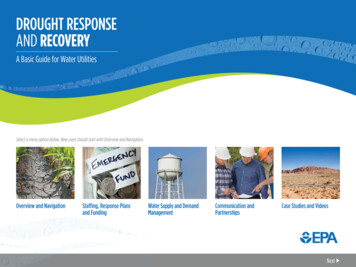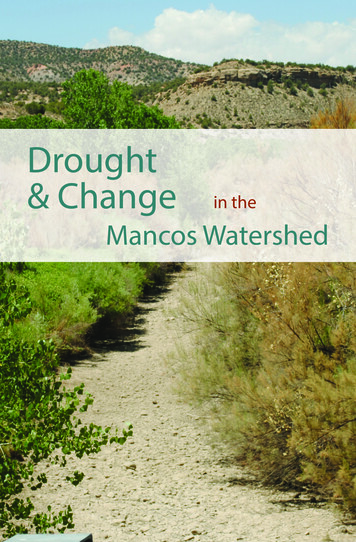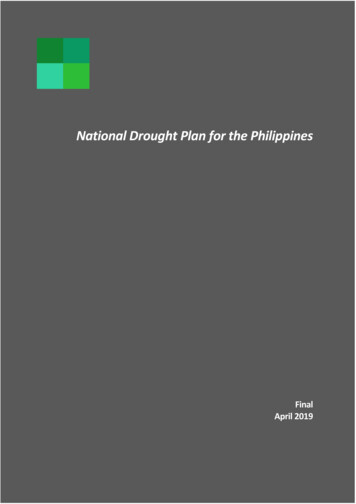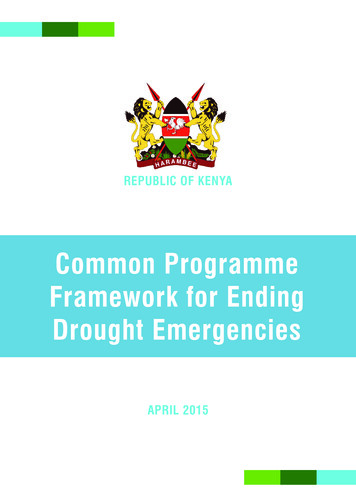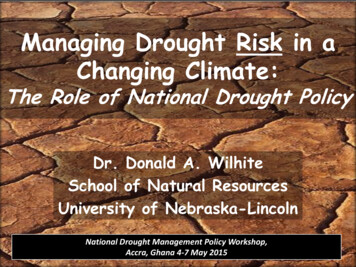
Transcription
Managing Drought Risk in aChanging Climate:The Role of National Drought PolicyDr. Donald A. WilhiteSchool of Natural ResourcesUniversity of Nebraska-LincolnNational Drought Management Policy Workshop,Accra, Ghana 4-7 May 2015
Presentation Outline INTRODUCTION Drought as hazard, characteristics, definitionThe MANY FACES OF DROUGHTBreaking the HYDRO-ILLOGICALCYCLE Crisis management Risk management Our CHANGINGCLIMATE—CHANGINGVULNERABILITYBuilding SOCIETAL RESILIENCE --What arethe ‘pillars’ for change? Drought monitoring and prediction, earlywarning/information delivery systems Vulnerability/risk and impact assessment Mitigation AND response measures Moving towards a POLICY FRAMEWORK that enhancespreparedness and risk reductionApplied Climate SciencesSchool of Natural Resources
Two Phrases to Remember If you do what you’ve always done,you’ll get what you’ve always got!– "You cannot solve current problems withcurrent thinking. Current problems are theresult of current thinking." Albert Einstein Who and what is at risk and why?– Issues of vulnerability and risk reduction– Building resilience, increasing copingcapacity and institutional capacity
Defining Drought-Hundreds of definitions—application and region specificDrought is a deficiency of precipitation (intensity)from expected or “normal” that extends over a seasonEffectivedroughtmanagementmustor longer period of time (duration) . . . . .be INTEGRATED across sectors andMeteorologicalDroughtwithinand betweenlevels ofand is insufficientasto meethumangovernmentwelltheasdemandswith ofNGOs.activities and the environment (impacts).Agricultural,Hydrological andSocio-economicDrought
Drought– it sneaks up on you!
Droughts differ in terms of:Spatial ExtentAs with other natural hazards,each drought event is unique in its physicalcharacteristics and impacts.
Western U.S.California
USDM AnimationJanuary 2011 to November 2014
European DroughtObservatory
Natural and Social Dimensions of DroughtDecreasing emphasis on the natural event (precipitation deficiencies)Increasing emphasis on water/natural resource management & policyIncreasing complexity of impacts and conflictsDrought lRainfallDeficienciesHeat StressWater SupplySnow psRangeSocio-economicLivestockForests Societal ImpactTime/Duration of the event
The Many Faces of Drought
Major Drought Areas—2012Drought differs from one region to another in termsof its physical characteristics, impacts, vulnerabilitiesand coping capacity (mitigation and response).Drought policies cannot be prescriptive since each countryin unique in institutional structure, legal framework, etc.
Drought is a normal part of climate!DROUGHTS ARE “WINDOWS OFOPPORTUNITY” TO IMPROVEDROUGHT MANAGEMENT!
Breaking the Hydro-illogical Cycle:An Institutional Challenge for Drought ManagementCrisis ManagementIf you do whatyou’ve alwaysdone, you’ll getwhat you’vealways got.We MUSTadopt a newparadigm fordroughtmanagement!
Crisis Management Characteristics Ineffective, treats symptoms of droughtUntimely, response actionsIncreases reliance on government/donorsPoorly coordinated, national to local levelactions Expensive, large expenditures fromnumerous government agencies (anddonors) Increases vulnerability?
Emergency response has a place indrought risk management, but it can alsolead to: greater vulnerability/decreasedresilience to future drought events increased reliance on government anddonor interventions.The CHALLENGE is to identify emergencyresponse options that will also promote ‘riskApplied Climate SciencesSchool of Natural Resourcesreduction’.
Types of Policy Responses Post-impact government interventions—relief measures (i.e., crisis management) Pre-impact government programs—mitigation measures to reduce vulnerabilityand impacts, including insurance programs Risk-based drought policies andpreparedness plans, organizationalframeworks and operational arrangements
The Cycle of Disaster ManagementRisk management increases coping capacity, builds resilience.proactivePromotes a shift from managingdisasters to managing risk!reactiveCrisis management treats the symptoms, not the causes.
Drought Risk ManagementWho and what is at risk and why?(Sayers et al., 2015)
Strategic Risk-based Approach forBuilding Drought ResilienceDetermining the right balance of measures:A portfolio approachSayers et al., 2015
EXPOSURE Severity/Magnitude- Intensity/Duration Frequency Spatial extent Trends- Historical- Future Impacts Early warningApplied Climate SciencesSOCIAL FACTORS Population growth Population shifts Urbanization Technology Land use changes Environmentaldegradation Water use trends Governmentpolicies EnvironmentalawarenessRISKSchool of Natural Resources
Changes in Societal VulnerabilityDrought impacts are morecomplex today as moreeconomic sectors are affected,creating more conflicts betweenwater users, i.e., societalvulnerability is dramaticallydifferent and changing. Agricultural production Food security Energy Transportation Tourism/Recreation Forest/rangeland fires Municipal water Water quality/quantity Environment Ecosystem services Health
Incentives for Changing theParadigm Addresses spiraling impacts multiple sectors Reduces conflicts between water users Promotes wise stewardship of naturalresources—sustainable development Reduces need for governmental assistance—allows for resources to be invested more wisely More frequent and severe droughts (increasedduration?) in association with climate change. What is the cost of inaction?
Needed Actions for Change:Reducing Societal Vulnerability Improve drought awareness Develop/improve monitoring, seasonal forecasts,early warning and information delivery systems Improve decision support tools Complete risk assessments of vulnerablesectors, population groups, regions Improve understanding and quantification ofdrought impacts vs. mitigation costs (4:1 ratio) Develop and implement drought preparednessplans Create national drought policies based on theprinciples of risk reduction
Our Changing ClimateThere is a close correlation between CO2 and temperature that has been verified through manylines of research . This graph shows the relationship of temperature and CO2 over the last 130years.
Natural Catastrophes 020010010019801982198419861988Geophysical events(Earthquake, tsunami,volcanic eruption)199019921994199619982000Meteorological events(Storms, etc.) 2013 Münchener Rückversicherungs-Gesellschaft, Geo Risks Research, NatCatSERVICE – As at January 2013200220042006200820102012Hydrological events(Flood, mass movement)Source: Munich Re
The Climate Change Challenge forDrought Management Increasing mean temperature High temp. stress and heat waves/longergrowing seasons Increased evapotranspiration Changes in precipitation amount,distribution, intensity and form Reduced soil moisture Changes in groundwater recharge Reduced runoff/stream flow resulting fromreduced snowpack/sublimationApplied Climate SciencesSchool of Natural Resources
Building SocietalResiliencethrough NationalDrought Policiesand PreparednessPlans: The WayForwardApplied Climate SciencesSchool of Natural Resources
Necessary Ingredients for NationalDrought Policy Development Political will and leadership! Initial investment in building greaterinstitutional capacity Collaborative environment that supportsand encourages coordination within andbetween levels of government/privatesector Engaged and supportive stakeholders Engaged research community Strong outreach and media program
National Drought PolicyPreparedness Plans basedon the principles of riskreduction
A drought policy should bebroadly stated and . . . Establish a clear set of risk-based principles orguidelines to govern drought management. Policy could be part of a disaster risk reductionor climate change adaptation framework Consistent and equitable for all regions,population groups, and economic/social sectors. Consistent with the goals of sustainabledevelopment. Reflect regional differences in droughtcharacteristics, vulnerability and impacts.
A drought policy should(continued) Promote the principles of risk management byencouraging an integrated drought managementapproach at all levels– Early warning and delivery systems; Monitoring, reliable seasonal forecasts;– Preparedness plans at all levels of government, withinriver basins, and the private sector;– Vulnerability assessments —who and what is at riskand why?– Mitigation actions and interventions that reducedrought impacts and the need for governmentintervention;– Coordinated emergency response that ensurestargeted and timely relief, consistent with drought policygoals, during drought emergencies.
Where do we start?Mapping out a ired?Cost?
Key Elements/Pillars of aDrought Preparedness Plan Monitoring/early warning, predictionand information delivery systems– Integrated monitoring of key indicators Precipitation, temperature, soil moisture,streamflow, snowpack, groundwater, impacts,etc.– Use of appropriate indices– Reliable seasonal forecasts– Development/delivery of information andsector-specific decision-support tools
Key Elements/Pillars of aDrought Preparedness Plan Risk/Vulnerability and impact assessment– Conduct of risk/vulnerability assessments– Monitoring/archiving of impacts/losses Critical for evaluating progress in riskreduction and also for vulnerabilityassessment Mitigation and response– Proactive measures to increase coping capacity– Response measures that support the principlesof drought risk reduction Examples
3 Pillars of Drought Policy &Preparedness with LinkagesMonitoring/EarlyWarning & Info.DeliveryDrought status (Met.,Agric., Hydro. & Socioeconomic)FeedbackDrought characterizationstudiesVulnerability andImpact AssessmentWho/What is at RISK & Why?Prioritization/RankingIntegrated DroughtManagementMitigation andResponseActions and measures to mitigate droughtimpacts and respond to drought emergencies(short-, medium- & long-term)
Monitoring, Early Warning &Information Delivery SystemsIndicators/Indices Precipitation Temperature Surface water supplies–––––Stream flowSoil MoistureReservoir levelsSnow packWater use Ground water Remotely-sensed data (e.g.,plant water stress) Impacts– By sector, areaAgencies/Ministries/Organizations Water Meteorological & HydrologicalServices Agriculture, Forestry & Fisheries Environment Health Energy Transportation Commerce Social Services NGOs Others
Vulnerability/Impact Assessment,Mitigation and ResponseWho and What is at RISK and Why?By SectorAgencies, Organizations & AgricultureStakeholder Groups Energy Environment, Recreation & Tourism Reps from Ministries and Transportationnon-governmental Healthorganizations Commerce Others Communities & regionalorganizationsBy Area/Region Stakeholder groups Drought managementrepresenting all impactareas (provinces, riversectorsbasins) Communities (rural, urban) Others Indigenous population
Defining and CharacterizingVulnerability Vulnerability refers to the inability to withstand theeffects of a hostile environment (drought). Vulnerability is the diminished capacity of anindividual or group to anticipate, cope with, resistand recover from the impact of a natural or manmade hazard. (Resilience) Vulnerability is dynamic. Vulnerability arises when people are at risk throughtheir exposure to a shock or stress associated with anatural hazard. People, sectors, communities and institutions differin their exposure and vulnerability to risk (copingcapacity).
Addressing Vulnerability To determine people’s vulnerability, twoquestions need to be asked:– Who and what is vulnerable?– Why are they vulnerable? Addressing vulnerability requires:– reducing the impact of the hazard itself wherepossible (through mitigation, prediction and earlywarning, preparedness, education, etc.);– building capacity to withstand and cope withhazards;– tackling the root causes of vulnerability, such aspoverty, poor management of natural resources,government policies, inadequate training ormanagement skills, access to resources.
Coping Capacity and ResiliencyCoping Capacity: The ability of people,organizations and systems, using availableskills and resources, to face and manageadverse conditions, emergencies or disasters.Improving coping capacity contributes to thereduction of risk (managing risk vs. managingdisasters)Resiliency: The ability to recover quickly whenexposed to a stressor or shock. Climate change increased frequency ofdrought policies & preparedness reduced impacts and recovery time
A series ofregional workshopssponsored byWMO, FAO,UNCCD, UNWater and theConvention onBiological Diversity(Eastern Europe,Latin America,Asia and Africa)
Framework for IDMP’s work on Drought Policies:National Drought Management Policy Guidelines Adapting of 10-step planningprocess by Don Wilhite tonational drought policydevelopment Response to a needarticulated at High-levelMeeting on National DroughtPolicy (HMNDP) Template that can be adaptedto national realities and needs Building on existing riskmanagement capacities
National Drought Policy:A 10-Step ProcessStep 1Appoint a national drought policy commissionStep 2State or define the goals and objectives of a riskbased national drought management policyStep 3Seek stakeholder participation and define/resolveconflicts between key water use sectors, consideringtransboundary implications.Inventory data and financial resources availableand identify groups at riskPrepare/write the key tenets of a national droughtmanagement policy and preparedness plansStep 4Step 5(monitoring, early warning and prediction; risk and impactassessment; mitigation and response)
Risk Assessment: Purpose To identify those sectors, populationgroups, or regions most at risk fromdrought, most probable impacts, andmitigation actions that will reduceimpacts to future events.Who and what is at risk and why?Vulnerability Profile
National Drought Policy:A 10-Step Process(continued)Step 6Identify research needs and fill institutional gapsStep 7Integrate science and policy aspects of droughtmanagementStep 8Publicize the national drought management policyand preparedness plans, build public awarenessand consensusDevelop education programs for all age andstakeholder groupsStep 9Step 10Evaluate, test and revise drought managementpolicy and supporting preparedness plans
Drought Task Assessment ReportsRisk Assessment andMitigation CommitteeCommittee(early warning &information delivery)Situation ReportsDrought PlanOrganizationalStructureWorkingGroups(sectors)
Takeaway Messages Drought is a normal part of climate. Changing precipitation amounts, seasonal distribution, form Increasing temperatures will increase ET and droughtseverity, frequency and duration. Past drought management efforts have been reactive—ineffective, poorly coordinated & poorly targeted (crisismanagement). Managing sector impacts—increase resilience to drought. Integrated drought management requires a collaborativeapproach within and between levels of government and theprivate sector for monitoring and early warning, risk/vulnerabilityassessment and mitigation and response. Time is NOW to change the paradigm from crisis to droughtrisk management through integrated drought management. The ‘cost of inaction’!
Thanks for your attention!Applied Climate SciencesContact Information:School of Natural ResourcesUniversity of Nebraska-Lincolndwilhite2@unl.eduSchool of Natural Resources
National Drought Management Policy Guidelines Adapting of 10-step planning process by Don Wilhite to national drought policy development Response to a need articulated at High-level Meeting on National Drought Policy (HMNDP) Template that can be adapted to national realities and needs Building on existing risk management capacities
